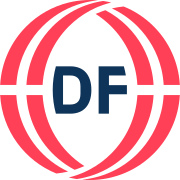Danish People's Party Dansk Folkeparti | |
|---|---|
 | |
| Abbreviation | DF O[a] |
| Leader | Morten Messerschmidt |
| Parliamentary leader | Peter Kofod |
| Founded | 6 October 1995 |
| Split from | Progress Party |
| Headquarters | Christiansborg, 1240 Copenhagen |
| Youth wing | Youth of the Danish People's Party |
| Membership (2021) | 9,427[1] |
| Ideology | |
| Political position | Right-wing to far-right |
| Religion | Evangelical Lutheran Church of Denmark |
| European Parliament group | Patriots for Europe (since 2024)[nb 1] |
| Nordic Council affiliation | Nordic Freedom |
| Colours | |
| Folketing | 7 / 179[b] |
| European Parliament | 1 / 15 |
| Regional Councils[5] | 4 / 205 |
| Municipal Councils[6] | 62 / 2,436 |
| Mayors | 0 / 98 |
| Election symbol | |
O | |
| Party flag | |
 | |
| Website | |
| danskfolkeparti | |
The Danish People's Party (Danish: Dansk Folkeparti, DF; or sometimes in English: DPP) is a nationalist and right-wing populist political party in Denmark. It was formed in 1995 by former members of the Progress Party (FrP).
The party saw a period of significant growth after its founding and lent its support to the Venstre–Conservative People's Party coalition government that ruled from the general election of 2001 until the 2011 election defeat. While not part of the cabinet, DF cooperated closely with the governing coalition on most issues and received support for key political stances in return, to the point that the government was commonly referred to as the "VKO-government" (O being DF's election symbol).[7] It also provided parliamentary support to Lars Løkke Rasmussen's cabinets from 2016 to 2019, again without participating in it. In the 2014 European Parliament election in Denmark, DF secured 27% of the vote as part of the European Conservatives and Reformists group. This was followed by receiving 21% of the vote in the 2015 general election, becoming the second largest party in Denmark for the first time.
However, since 2015, the party has since seen a decline in support, falling to 3rd place and 10.8% of the vote in the 2019 European Parliament election in Denmark, and to just 8.7% in the 2019 Danish general election, resulting in a loss of 21 seats and a return to opposition. The party would later lose over half of its seats in the 2021 Danish local elections, losing 130 of the 221 it held before the election, achieving just 4.1% of the vote. Some commentators attributed the losses to internal conditions within the party and conflicts with the leadership, its perceived indecisiveness in government and rival parties adopting many of its policy ideas. The DF would also suffer a number of defections during 2022 following the rise of the Denmark Democrats party which many former DF members and supporters joined.[8][9][10][11] It would receive its worst general election result ever in 2022, when it only won five seats. As of February 2023[update], due to defections from Nye Borgerlige, DF now has seven of the seats in the Danish Folketing.
Cite error: There are <ref group=lower-alpha> tags or {{efn}} templates on this page, but the references will not show without a {{reflist|group=lower-alpha}} template or {{notelist}} template (see the help page).
- ^ Hoffmann-Hansen, Henrik; Nilsson, Simone; Jespersen, Johan Storgaard; Krasnik, Benjamin; Fabricius, Kitte; Schmidt, Mara Malene Raun; Gosmann, Mie Borggreen Winther og Sara Mathilde (3 October 2022). "Overblik: Partierne i Danmark". Kristeligt Dagblad (in Danish). Retrieved 4 January 2023.
- ^ "Farvekoder" (PDF). Danskfolkeparti.dk. Retrieved 18 September 2021.
- ^ KORT Da Dansk Folkeparti blev størst i hele Danmark. DR.
- ^ "DF står til markant tilbagegang i Sydjylland: S bliver størst" [DPP expected to decline in Southern Jutland: S will be biggest]. Berlingske Tidende. Ritzau. 28 May 2019. Retrieved 22 February 2020.
- ^ "AKVA3: Valg til regions råd efter område, parti og stemmer/kandidater/køn". Statistics Denmark. Retrieved 13 June 2010.
- ^ "VALGK3: Valg til kommunale råd efter område, parti og stemmer/kandidater/køn". Statistics Denmark. Retrieved 13 June 2010.
- ^ Cite error: The named reference
dsdwas invoked but never defined (see the help page). - ^ "Tidligere DF'er Hans Kristian Skibby vil også være med i Støjbergs parti | Nyheder". DR (in Danish). 25 June 2022. Retrieved 2 November 2022.
- ^ "Endnu en tidligere DF'er melder sig klar for Danmarksdemokraterne | Nyheder". DR (in Danish). 25 June 2022. Retrieved 2 November 2022.
- ^ "Jens Henrik Thulesen Dahl melder sig ind i Støjbergs nye parti - TV 2". nyheder.tv2.dk (in Danish). 24 June 2022. Retrieved 2 November 2022.
- ^ "Peter Skaarup forlader Dansk Folkeparti: Vil være kandidat i Inger Støjbergs nye parti". DR (in Danish). 24 June 2022. Retrieved 2 November 2022.
Cite error: There are <ref group=nb> tags on this page, but the references will not show without a {{reflist|group=nb}} template (see the help page).